What you can do to help - exploring tools for Raising the Grade!
Vanessa Vargas-Nguyen, Sara Morales ·Sara Morales and Vanessa Vargas-Nguyen
As we are approaching the end of our report card course, our last week’s class focused on the final phase of the report card process - Raising the grade! The report card is a great tool to communicate the status of ecosystem health and help raise awareness but it is lacking in providing recommendations that can help stakeholders improve ecosystem health. Therefore, various tools are being explored by the Integration and Application Network that can help to explain the relationships among ecosystem and social factors at local and large-scale level for “Raising the Grade”. These tools that are discussed in our lecture are: Consensus Approaches, System Dynamics Modelling and Socio-ecological Network Analysis.
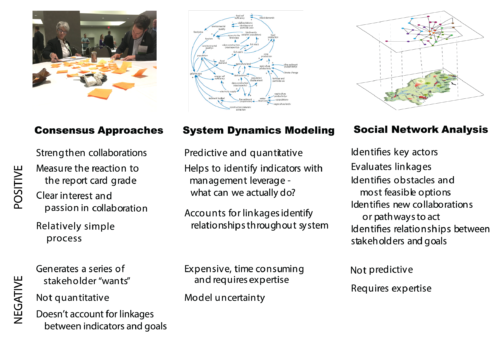
Report cards traditionally include recommendations that the public, policy makers and government can do to help improve ecosystem health based on the consensus approach. This can be seen in the Mississippi River Report Card where a group of stakeholders from the Upper Mississippi came together, and in response to the report card grade developed an action agenda that was delivered to Congress. This process was very collaborative and consensus driven. Some of these recommendations could also be based on expert opinion and a basic understanding of the connections between indicators. However, it is important to note that some technically good options could be available, but might not be acceptable or feasible in terms of the socio-economic reality (funding, politics, uncertainty of effects, etc).
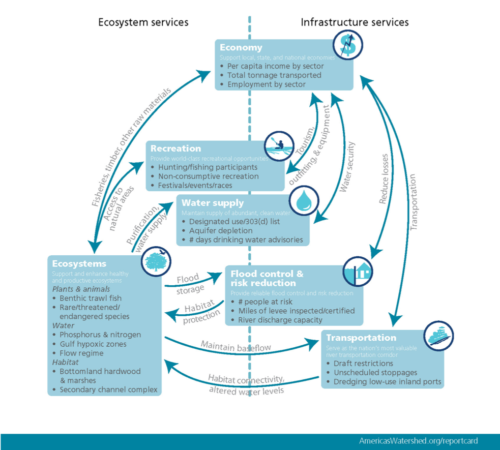
An important next step in the evolution of report cards is to be able to illustrate the relationships or connection among ecosystem services (given by natural capital) and infrastructure services (economic relevance) in order to promote an equilibrium among them. And try to answer questions such as: What happen if we do or do not intervene with actions, politics or practices? How can we improve conditions? What are the best options? How will investments in one area affects others? What is feasible politically, socially, and economically? This mean that there must be a depth knowledge of the system as well as an engagement from all stakeholders to propose feasible goals and actions. Tools that can help are system dynamics modelling and socio-ecological network analysis.
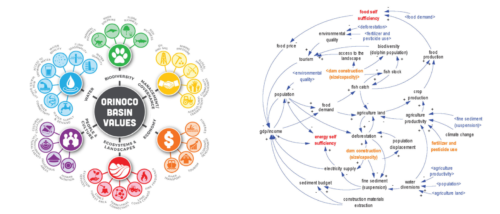
System dynamics modelling can describe how ecosystem functions, enabling varied management scenarios to be run, and provide recommendations on what actions will have the greatest positive environmental outcome. For example, maybe if we used to get an A in the past in our system and now we get a C in the future, sometimes we couldn't be able to return to an A and barely get a B. We can identify actions that can lead to a particular scenario. System Dynamics Modelling has been explored in the Mekong Flooded Forest and the Orinoco River.
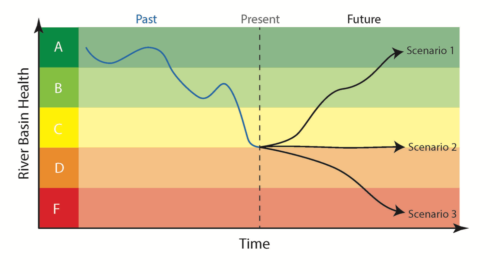
The next tool is socio-ecological network analysis that builds on social network analysis. Social Network Analysis (SNA) can potentially show the interconnection between different indicators (ecological, socio-cultural, economic, health and governance indicators and certain characteristics of the network can also be used themselves as indicators in report cards, such as network density on or fragmentation, centrality measures and the type of network structure formed. In addition, SNA can identify key stakeholders and opinion leaders, to help design targeted communication strategies.
The social network structure tell us about the groups capacity for collective actions, and IAN group recommended to do it at the beginning and at the end of the report card process as it can also be used for evaluating the impact of report cards. Our Teaching Assistant, Vanessa Vargas-Nguyen showed an example of how SNA can do thing using our class network as an example. Vanessa showed the network structure of our class before and after our report card course based on a survey that we completed.
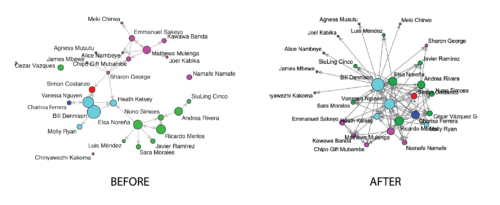
Management and stakeholder actions can affect multiple indicators and goals, so it is important to identify and prioritize actions that stakeholders can implement and rally behind. For report cards to go beyond a tool for science communication and environmental literacy, to an agent of behavior and environmental change, understanding the interconnection of social and environmental systems is very much needed.

